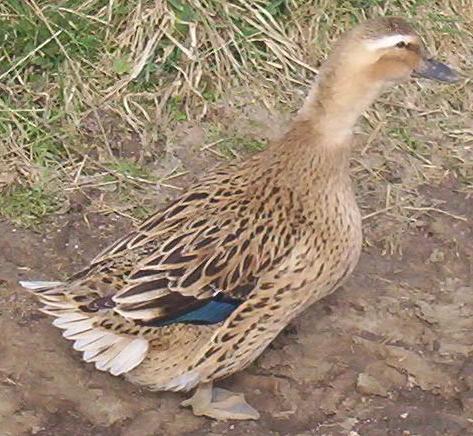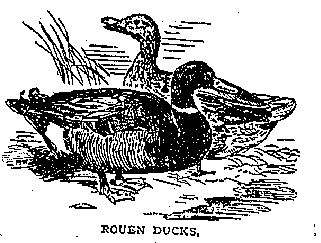Rouen Duck on:
[Wikipedia]
[Google]
[Amazon]

 The Rouen is a heavyweight breed of domesticated duck raised primarily for decoration, exhibition or as general purpose ducks. Since they are not prolific egg layers, Rouen ducks are most commonly bred for their meat. The breed originated in
The Rouen is a heavyweight breed of domesticated duck raised primarily for decoration, exhibition or as general purpose ducks. Since they are not prolific egg layers, Rouen ducks are most commonly bred for their meat. The breed originated in
 The Rouen is a heavyweight breed of domesticated duck raised primarily for decoration, exhibition or as general purpose ducks. Since they are not prolific egg layers, Rouen ducks are most commonly bred for their meat. The breed originated in
The Rouen is a heavyweight breed of domesticated duck raised primarily for decoration, exhibition or as general purpose ducks. Since they are not prolific egg layers, Rouen ducks are most commonly bred for their meat. The breed originated in France
France (), officially the French Republic ( ), is a country primarily located in Western Europe. It also comprises of overseas regions and territories in the Americas and the Atlantic, Pacific and Indian Oceans. Its metropolitan ar ...
sometime before the 19th century.
Description
The plumage coloring of both the Rouen drake and the Rouen duck are nearly identical to that of theMallard
The mallard () or wild duck (''Anas platyrhynchos'') is a dabbling duck that breeds throughout the temperate and subtropical Americas, Eurasia, and North Africa, and has been introduced to New Zealand, Australia, Peru, Brazil, Uruguay, Arge ...
drake and Mallard duck. The Mallard color pattern is referred to as gray. Males have green heads, white collars, black tail coverts and dark, ashy brown tail feathers, a gray body, and a deep claret breast. The female Rouen hens are a consistent shade of mahogany brown, with a brown crown and tan eye-stripes extending from bill to the back of the eyes. Another feature of the female color pattern is the distinct, detailed penciling found on feathers of the head, neck, body, most of the wing and tail. Rouen females can be much darker brown than Mallard females. Both sexes also have blue speculum feathers
The speculum is a patch, often distinctly coloured, on the secondary wing feathers, or ''remiges'', of some birds.
Examples of the colour(s) of the speculum in a number of ducks are:
* Common teal and green-winged teal: Iridescent green edged ...
. However, Rouen speculum feathers are brighter in color and larger in size than that of the Mallard. Adult Rouen ducks are typically significantly larger than Mallard ducks. The Rouen duckling is identical to the Mallard duckling in terms of plumage coloring. In North America, two distinct types are bred: the common, or production-bred, variety that is larger than a Mallard but has a typical duck conformation, and the much larger and squarer standard-bred variety. The production variety normally weighs 6–8 lbs (2.7–3.6 kg) while the standard-bred weighs 9–12 lb (4.1–5.4 kg).
Rouen ducklings can be distinguished from wild mallard ducklings by the presence of a second stripe which runs across their face, just under their eye, whereas mallard ducklings have only one stripe which runs across their eye.
History
The breed was first raised in France, but it was not until it reachedEngland
England is a country that is part of the United Kingdom. It shares land borders with Wales to its west and Scotland to its north. The Irish Sea lies northwest and the Celtic Sea to the southwest. It is separated from continental Europe ...
in the 19th century that it was refined into the breed recognized as the Rouen today. The French version resembled a larger than average Mallard, but by selective breeding, the British developed the exhibition-type Rouen. The final product was a bird with a deep, long keel, boat-shaped profile, enormous appearance, and refined markings, especially the penciling on the female. It was used chiefly as a roasting bird; though it produced 35 to 125 eggs a year, there were other breeds which were more reliable egg-layers with higher production. The eggs are typically white but can have blue and green tints. Exhibition-typed Rouen ducks have been known to crush their eggs if allowed to set due to their massive frames. In 1861, Mrs. Beeton
Isabella Mary Beeton ( Mayson; 14 March 1836 – 6 February 1865), known as Mrs Beeton, was an English journalist, editor and writer. Her name is particularly associated with her first book, the 1861 work ''Mrs Beeton's Book of Household ...
said of it:
The origin of the name is not known. When they arrived in England, they were variously called the Rhône, after the region in southwest-central France, Rohan, after the cardinal of that name, Roan, for the mixture of colors, and Rouen
Rouen (, ; or ) is a city on the River Seine in northern France. It is the prefecture of the region of Normandy and the department of Seine-Maritime. Formerly one of the largest and most prosperous cities of medieval Europe, the population ...
after the northern French town, with Rouen eventually being adopted in both England and France. In France, they are called Rouen Foncé (dark) as opposed to Rouen Clair, which are lighter in color.
In 1850 the first Rouens were introduced to the United States by D. W. Lincoln of Worcester, Massachusetts
Massachusetts (Massachusett language, Massachusett: ''Muhsachuweesut assachusett writing systems, məhswatʃəwiːsət'' English: , ), officially the Commonwealth of Massachusetts, is the most populous U.S. state, state in the New England ...
, and used as general farm ducks until becoming popular as show birds. They were included in the ''Standard of Perfection'' of the American Poultry Association
The American Poultry Association (APA) is the oldest poultry organization in the North America. It was founded in 1873, and incorporated in Indiana in 1932.
The first American poultry show was held in 1849, and the APA was later formed in resp ...
in 1874 and since then have won many titles, often having the most entries in the heavyweight class and doing well in competition with other breeds.
See also
*List of duck breeds
This is a list of the breeds of domestic duck which have official recognition at national or international level.
Most breeds of duck derive from the wild mallard, ''Anas platyrhyncos'', while a small minority are descendants of the Muscovy duck ...
References
* * {{Authority control Duck breeds Duck breeds originating in France Animal breeds on the RBST Watchlist Animal breeds on the GEH Red List